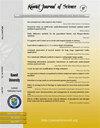Comparative assessment of physicochemical and biological properties of silver nanoparticles (AgNPs) synthesized from aerial and underground parts of Arnebia benthamii
IF 1.1
4区 综合性期刊
Q3 MULTIDISCIPLINARY SCIENCES
引用次数: 0
Abstract
Arnebia benthamii is a source of secondary metabolites with significant medicinal potential. This work studied the biogenic synthesis of silver nanoparticles (AgNPs) by A. benthamii root and inflorescence extracts. The novelty of this research lies in the comparative assessment of nanoparticles derived from aerial and underground plant parts, highlighting differences in physicochemical and biological properties. A 1:5 ratio of plant extract to silver nitrate (AgNO3) solution (1 mM) was used in the formation of NPs, and they were characterized by UV-Vis spectroscopy (UV), Fourier transform infrared spectroscopy (FTIR), scanning electron microscopy (SEM), and X-ray diffraction spectroscopy (XRD). UV-Vis analysis confirmed AgNP formation by an absorbance peak at 432 nm (root-mediated) and 436 nm (inflorescence-mediated). XRD confirmed their crystalline nature, while SEM revealed that root-derived AgNPs were irregular (40 nm) and inflorescence-derived AgNPs were spherical (23 nm). FTIR showed the part of secondary metabolites that serve as natural capping agents. For antibacterial activity, the well diffusion method was employed, where AgNPs were tested against Acinetobacter calcoaceticus and Enterobacter hormaechei subsp. xiangfangensis. Inflorescence-mediated AgNPs were found to exhibit superior antibacterial activity, likely due to smaller NP size. For antioxidant assays, these AgNPs also demonstrated enhanced 2,2-diphenyl-1-picrylhydrzyl (DPPH) of 83 % and 2,2-azino-bis(ethylbenzothiazoline-6-suphonic acid) (ABTS) of 61 % compared to root-mediated AgNPs (DPPH 80 %, ABTS 57 %). The findings suggest that A. benthamii-mediated AgNPs possess a significant potential for biological applications. Enhanced bioactivity of inflorescence-derived AgNPs highlights their promise in antimicrobial and antioxidant therapies, supporting their future use in pharmaceutical and nanotechnological advancements.
从空中和地下部分合成银纳米粒子(AgNPs)的物理化学和生物特性的比较评估
本胺是一种具有重要药用潜力的次生代谢物来源。本文研究了以香草根和花序提取物为原料合成纳米银的生物源性。这项研究的新颖之处在于对来自地上和地下植物部分的纳米颗粒进行了比较评估,突出了物理化学和生物特性的差异。采用植物提取物与硝酸银(AgNO3)溶液(1 mM)的比例为1:5形成NPs,并通过紫外可见光谱(UV)、傅里叶变换红外光谱(FTIR)、扫描电镜(SEM)和x射线衍射光谱(XRD)对NPs进行了表征。紫外-可见分析证实AgNP形成的吸收峰在432 nm(根介导)和436 nm(花序介导)。XRD证实了AgNPs的结晶性质,SEM显示根源AgNPs为不规则型(40 nm),花序源AgNPs为球形(23 nm)。FTIR显示部分次生代谢物作为天然封顶剂。采用孔扩散法测定AgNPs对钙酸不动杆菌和霍马切肠杆菌的抑菌活性。xiangfangensis。发现花序介导的AgNPs具有优越的抗菌活性,可能是由于较小的NP大小。在抗氧化实验中,与根介导的AgNPs (DPPH为80%,ABTS为57%)相比,这些AgNPs还显示出2,2-二苯基-1-吡啶基羟基(DPPH为83%)和2,2-氮基-双(乙基苯并噻唑-6-亚磺酸)(ABTS为61%)的增强。研究结果表明,a . benthami介导的AgNPs具有重要的生物学应用潜力。花序衍生AgNPs的生物活性增强凸显了它们在抗菌和抗氧化治疗中的前景,支持它们未来在制药和纳米技术进步中的应用。
本文章由计算机程序翻译,如有差异,请以英文原文为准。
求助全文
约1分钟内获得全文
求助全文
来源期刊

Kuwait Journal of Science
MULTIDISCIPLINARY SCIENCES-
CiteScore
1.60
自引率
28.60%
发文量
132
期刊介绍:
Kuwait Journal of Science (KJS) is indexed and abstracted by major publishing houses such as Chemical Abstract, Science Citation Index, Current contents, Mathematics Abstract, Micribiological Abstracts etc. KJS publishes peer-review articles in various fields of Science including Mathematics, Computer Science, Physics, Statistics, Biology, Chemistry and Earth & Environmental Sciences. In addition, it also aims to bring the results of scientific research carried out under a variety of intellectual traditions and organizations to the attention of specialized scholarly readership. As such, the publisher expects the submission of original manuscripts which contain analysis and solutions about important theoretical, empirical and normative issues.
 求助内容:
求助内容: 应助结果提醒方式:
应助结果提醒方式:


